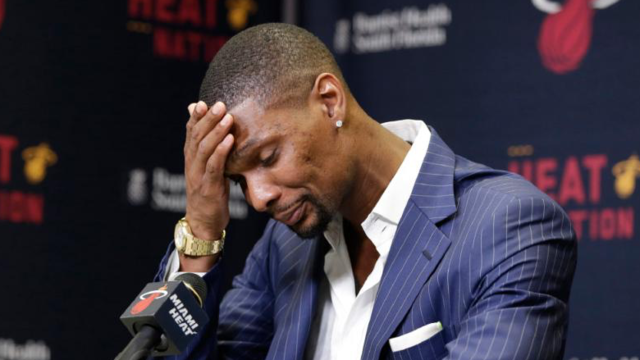
The last couple seasons have been a trying time for Chris Bosh.
The 11-time NBA All-Star and two-time NBA champion has had his season cut short each of the past two seasons because of very serious blood clotting issues in his legs.
He has not suited up since before the 2016 NBA All-Star break and despite he and his wife’s pleas. He was officially ruled out for the remainder of the 2016 NBA Playoffs this week, despite the fact that the Heat may very well have the chance to play in the eastern conference finals against his former running mate LeBron James.
In order to be cleared to play again or be involved with any high intensity, high cardio activity safely, Bosh needs to be able to not be taking any blood thinners in order to avoid his blood clotting.
The mere fact that this issue has re-surfaced within a year of the initial prognosis even with Bosh having access to the best medical care and doctors and taking all of the necessary steps to prevent it means it could be something that he will deal with for the rest of his life, which puts a dark cloud of uncertainty over his NBA future even beyond the 2016 postseason.
As basketball fans, we are all too familiar with the risks associated with this sort of medical prognosis for a player and the tragedy that can occur if it is not dealt with an in extremely cautious manner.
Miami Heat Head Coach Erik Spoelstra saw it right before his eyes.
As a guard for the University of Portland Pilots in 1990, he was a few feet away from collegiate basketball star Hank Gathers of Loyola Marymount when he collapsed during their game on March 4, 1990 and died on the court.
Gathers passed away of cardiac arrest after refusing to take the heart medication that helped regulate his heart rhythms as a sufferer of an enlarged heart.
Here is a few excerpts from an ESPN story explaining the situation surrounding Gathers tragic death:
“[Gathers] was treated with Inderal, one of a class of beta blocker drugs that inhibits the effects of adrenaline and smoothes the heart’s rhythms. But Gathers detested the drug. He agonized over having to take it. The drug made him sluggish, moody. His game suffered. He was unable to run the court without getting tired. His shot was off. He’d get woozy at times. He’d sleep longer.”
“Gathers continually complained to his coaches and doctors about the drug, that the dosage had to be reduced. They said no. So gradually, Gathers began cutting down on the dosage, and began feeling much better. He also began skipping some of the required testing. He was playing a risky game.”
Here is a clip from the 30 for 30 ESPN Documentary about the tragedy:
https://t.co/MRgTbcFVjG via @youtube
— Eddie?? (@eddiegraham05) May 4, 2016
This is a situation that Spoelstra is all too familiar with and doesn’t want to experience again, especially with one of his own players, Chris Bosh.
Bosh is dealing with a different issue than Hank Gathers did, but he is still afflicted by a serious medical issue that could become fatal if not managed properly as was the fate with Gathers 26 years ago.
If Bosh were never to play in the NBA again, he would already be considered one of the better players in his era and a potential Hall of Famer as a 11-time All-Star and two-time NBA champion, a vital part of the Miami Heat dynasty. There is plenty of good basketball left in Bosh if he can find away to persevere and get past his issues without endangering his health or even his life.
We all want to see Chris Bosh playing in a Miami Heat uniform again, but it sounds like it won’t happen unless it is 100% safe for his health and his future. As tough of a pill as that may be to swallow, that is a good thing.


















